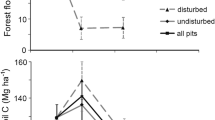Summary
The total weight of vegetation on an area of just over 1 acre of old secondary forest in the moist forest zone of Ghana has been determined, and found to be equivalent to roughly 150 tons per acre dry weight. The nutrient content of each component of the vegetation was also determined and showed that the amounts of the major nutrients immobilised in the vegetation were: N, 1,800 lb./acre; P, 120 lb./acre; K, 800 1b./acre; Ca, 2,400 lb./acre; Mg, 350 lb./acre. The corresponding amounts of nutrients in the top foot of soil supporting the vegetation were: total N, 4,100 lb./acre; ‘available’ P, 11 lb./acre; exchangeable K, 580 lb./acre; exchangeable Ca, 2,300 lb./acre; exchangeable Mg, 330 lb./acre. About half the nutrients stored in the vegetation were contained in readily combustible material, and except for N would be released to the soil if the forest were cleared and burnt for cultivation. The quantity of roots and the amounts of nutrients contained in them were not sufficiently great to make an important addítion to the nutrient supply in the soil during subsequent cultivation. Of the total quantity of roots supporting the vegetation 85.5 per cent by weight were within 1 foot of the soil surface.
Similar content being viewed by others
References
Alway, F. J., Maki, T. E. and Methley, W. J., Composition of the leaves of some forest trees. Am. Soil Survey Assoc. Bull.15, 81–84 (1957).
Bartholomew, W. V., J. Meyer and H. Laudelout, Mineral nutrient immobilisation under forest and grass fallow in the Yangambi (Belgian Congo) region, with some preliminary results on the decomposition of plant material on the forest floor. Publ. Inst. Nat. Étude Agron. Congo Belge Sér. Sci.,No. 57, pp. 27 (1953).
Beirneart, A., La technique culturale sous l'équateur. Publ. Inst. Nat. Étude Agron., Congo Belge Sér. Tech.No. 26, pp. 86 (1941).
Brammer, H., The soils of Ghana,in: Agriculture and Land Use in Ghana. Oxford University Press (in press).
Dawkins, H. C., The volume increment of natural tropical high forest, and limitations on its improvement. Empire Forestry Rev.38, 175–180 (1959).
Hutton, R. G. and Nye, P. H., The rapid determination of the major nutrient elements in plants. J. Sci. Food Agr.9, 7–14 (1958).
Istas, J. R. and Raekelboom, E. L., Contribution a l'étude chimique des bois de Mayumbe. Publ. Inst. Nat. Étude Agron. Congo Belge, Sér. Sci.No. 53, pp. 122 (1952).
Nye, P. H., The relative importance of fallows and soils in storing plant nutrients in Ghana. J. W. African Sci. Assoc.4, 31–50 (1958).
Reed, W. E., Reconnaissance soil survey of Liberia. U.S. Dept. Agr. Inform. Bull.No. 66 (1951).
Rennie, P. J., Uptake of nutrients by mature forest growth. Plant and Soil7, 49–95 (1956).
Taylor, C. J., The vegetation zones of the Gold Coast. Gold Coast Forestry Dept. Bull.No. 4, pp. 11 (1952).
Author information
Authors and Affiliations
Rights and permissions
About this article
Cite this article
Greenland, D.J., Kowal, J.M.L. Nutrient content of the moist tropical forest of Ghana. Plant Soil 12, 154–173 (1960). https://doi.org/10.1007/BF01377368
Received:
Issue Date:
DOI: https://doi.org/10.1007/BF01377368




